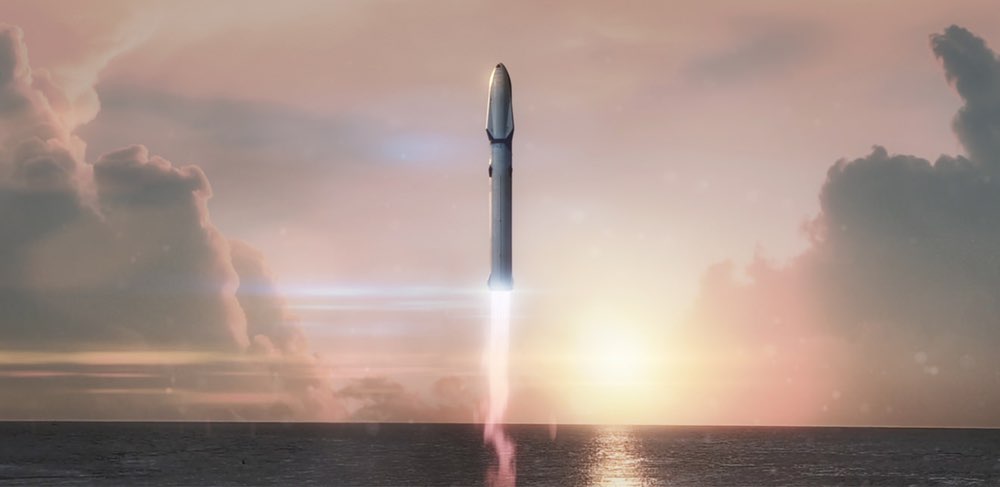SpaceX May Land Mars Rocket on the Launch Stand

SpaceX's Mars-colony missions may take "pinpoint rocket landing" to a whole new level.
Elon Musk's company has already brought a Falcon 9 booster safely down to Earth 11 times during orbital launches, on each occasion successfully targeting a relatively small landing zone: either the deck of a robotic ship at sea or a pad on terra firma near the launch site.
But these touchdowns could get even more precise when SpaceX starts flying its huge, reusable Mars rockets, which the company is developing to help establish a million-person city on the Red Planet. [SpaceX's Interplanetary Transport for Mars in Images]
"If you have been watching the Falcon 9 landings, you will see that they are getting increasingly closer to the bull's-eye," Musk wrote in a newly published commentary in the journal New Space that outlines SpaceX's Mars plans.
"In particular, with the addition of maneuvering thrusters, we think we can actually put the booster right back on the launch stand," he added. "Then, those fins at the base are essentially centering features to take out any minor position mismatch at the launch site."
Initially, that launch site will probably be the historic Pad 39A at NASA's Kennedy Space Center in Florida, which SpaceX has been leasing from the agency since 2014, Musk wrote. Pad 39A accommodated launches of NASA's Saturn V moon rocket, the most powerful vehicle ever to fly.
"In the future, we expect to add additional launch locations, probably adding one on the south coast of Texas, but this gives you a sense of the relative capability," Musk added in the New Space article, which puts to paper the vision he unveiled in September 2016 at a conference in Mexico.
Get the Space.com Newsletter
Breaking space news, the latest updates on rocket launches, skywatching events and more!
SpaceX's Mars rocket will be the strongest ever launched, capable of lofting 300 metric tons (330 tons) to low-Earth orbit (LEO) in the rocket's reusable variant, Musk wrote. (The Saturn V could get 135 metric tons, or 150 tons, to LEO.)
Such Mars rockets will loft colony spaceships to Earth orbit, as well as tankers that will fuel the colony craft. The boosters will then maneuver back to the launch site, where they'll be prepped to fly again in quick succession.
The spaceships, meanwhile, will linger in orbit until Mars and Earth are properly aligned, a window that opens every 26 months. The colony ships will then depart for the Red Planet en masse, carrying at least 100 people each.
All of these various components will be reusable, Musk said. Each rocket will be capable of launching 1,000 times, whereas each tanker and spaceship will fly about 100 and 15 times, respectively. (The spaceships will make the Earth-Mars trip in both directions.)
Such reusability is key to slashing costs, a requirement if Mars colonization is ever to become economically feasible, Musk said. He estimated that SpaceX's plan could reduce the price of a Mars trip to $200,000 or less per person, from the $10 billion or so it would cost using currently available rockets and spacecraft.
The first Mars colony ships could start launching in a decade or so if everything goes perfectly, Musk wrote.
You can download his New Space paper for free through July 5 here: http://online.liebertpub.com/doi/full/10.1089/space.2017.29009.emu
Follow Mike Wall on Twitter @michaeldwall and Google+. Follow us @Spacedotcom, Facebook or Google+. Originally published on Space.com.
Join our Space Forums to keep talking space on the latest missions, night sky and more! And if you have a news tip, correction or comment, let us know at: community@space.com.

Michael Wall is a Senior Space Writer with Space.com and joined the team in 2010. He primarily covers exoplanets, spaceflight and military space, but has been known to dabble in the space art beat. His book about the search for alien life, "Out There," was published on Nov. 13, 2018. Before becoming a science writer, Michael worked as a herpetologist and wildlife biologist. He has a Ph.D. in evolutionary biology from the University of Sydney, Australia, a bachelor's degree from the University of Arizona, and a graduate certificate in science writing from the University of California, Santa Cruz. To find out what his latest project is, you can follow Michael on Twitter.









